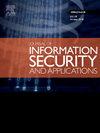ConZWNet:一种基于对比学习的高鲁棒性和可分辨性的零水印网络
IF 3.7
2区 计算机科学
Q2 COMPUTER SCIENCE, INFORMATION SYSTEMS
Journal of Information Security and Applications
Pub Date : 2025-06-28
DOI:10.1016/j.jisa.2025.104139
引用次数: 0
摘要
零水印是在不改变图像原始内容的情况下实现图像版权保护的有效方法。然而,目前基于深度学习的方法有两个关键的局限性。首先,大多数最初设计用于分类的特征提取网络缺乏抵抗攻击所必需的鲁棒特征学习。其次,传统方法很少将生成的水印重新纳入训练中,失去了进一步优化模型的机会。为了解决这些问题,我们提出了ConZWNet,这是一个将对比学习与反馈驱动的零水印生成相结合的两阶段框架。在第一阶段,我们使用ConvNeXt通过对弱-强增强的对比学习来学习不变的、抗攻击的特征。在第二阶段,残差网络与多层感知器(MLP)结合,融合主机图像和版权图像的特征,产生潜在的零水印,然后由基于MLP的版权识别网络进行验证。该反馈回路优化了特征融合,并将零水印生成转化为自监督过程。大量的实验表明,ConZWNet在确保主机图像和版权之间的高可区分性的同时,对各种攻击具有最先进的鲁棒性。研究证实了包括两阶段架构、对比学习、强弱增强和版权识别网络在内的组件的有效性。源代码可在https://github.com/hanhongxin1028/ConZWNet上公开获得。本文章由计算机程序翻译,如有差异,请以英文原文为准。
ConZWNet: A contrastive learning-based zero-watermarking network for high robustness and distinguishability
Zero-watermarking is an effective solution for image copyright protection without altering the original content. However, current deep learning-based methods suffer from two key limitations. First, most feature extraction networks, originally designed for classification, lack robust feature learning essential for resisting attacks. Second, conventional methods seldom incorporate the generated watermark back into training, missing opportunities to further optimize the model. To address these issues, we propose ConZWNet, a two-stage framework that integrates contrastive learning with feedback-driven zero-watermark generation. In the first stage, we use ConvNeXt to learn invariant, attack-resistant features via contrastive learning on weak–strong augmentation. In the second stage, a residual network coupled with a Multi-Layer Perceptron (MLP) fuses features from host and copyright images to produce a latent zero-watermark, which is then verified by an MLP-based copyright identification network. This feedback loop optimizes feature fusion and transforms zero-watermark generation into a self-supervised process. Extensive experiments demonstrate that ConZWNet achieves state-of-the-art robustness against various attacks while ensuring high distinguishability among host images and copyrights. Ablation studies confirm the effectiveness of components, including two-stage architecture, contrastive learning, weak–strong augmentation, and copyright identification network. The source code is publicly available at https://github.com/hanhongxin1028/ConZWNet.
求助全文
通过发布文献求助,成功后即可免费获取论文全文。
去求助
来源期刊

Journal of Information Security and Applications
Computer Science-Computer Networks and Communications
CiteScore
10.90
自引率
5.40%
发文量
206
审稿时长
56 days
期刊介绍:
Journal of Information Security and Applications (JISA) focuses on the original research and practice-driven applications with relevance to information security and applications. JISA provides a common linkage between a vibrant scientific and research community and industry professionals by offering a clear view on modern problems and challenges in information security, as well as identifying promising scientific and "best-practice" solutions. JISA issues offer a balance between original research work and innovative industrial approaches by internationally renowned information security experts and researchers.
 求助内容:
求助内容: 应助结果提醒方式:
应助结果提醒方式:


